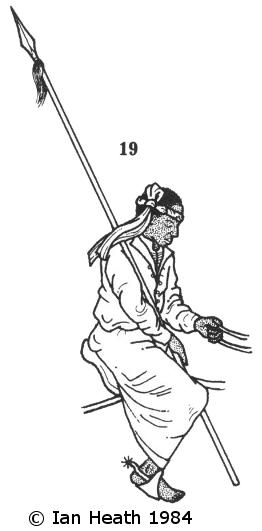
Try Amazon Fresh
MAMLUK SERVANT, 15th CENTURY
An extract from Armies of the Middle Ages, Volume 2by Ian Heath

 |
| [Based on The pilgrimage of Arnold von Harff in 1496 to 1499] |
19. MAMLUK SERVANT, 15th CENTURY
After the disbandment of the ex-Fatimid black regiments by Saladin and his successors, Negro soldiers disappeared from view so completely that, as Bernard Lewis states in his Race and Color in Islam, ‘black fighting-men did not reappear in the armies of Egypt for many centuries.’ Indeed, Ibn Iyas and other sources make it abundantly clear that the only capacity in which a Negro slave (’abd) could be found in the army during this period was as the servant of a mamluk, Arnold von Harff drawing such a servant in 1498 when he accompanied a Mamluk army from Cairo to Damascus, this figure being based on his drawing. Von Harff reported that the servant rode the second of the mamluk’s 3 horses, on which was also loaded ‘a small tent, meal, and other necessary provisions’. The lance he carries here is not his own (he is unarmed), but belongs to the mamluk. Elsewhere von Harff adds that mamluks had at least one servant, some having 30-40 and some even 2-300. Ayalon has pointed out that each mamluk was accompanied by at least one white servant called a ghulam, who as Qalqashandi explains was responsible for looking after the horses; the tasks for which the ’abd was responsible must therefore have been menial ones indeed.
Only very late in the Circassian era do black soldiers, as opposed to servants, reappear, when Sultan Qaytbay and his successors equipped several hundred ’abid with handguns, for which see page 42. The earliest reference to these black arquebusiers dates to 1490, when they were fielded against the Ottomans, which Ayalon therefore states to be ‘the earliest known date for the use of the handgun in the Mamluk kingdom’. However, there is one considerably earlier reference, Brocquière recording that the 30-odd guards of a caravan returning from Mecca that he encountered in 1432 included amongst their arms ‘small arquebuses, which they fired off every now and then.’ Ayalon’s date of 1490 can therefore only be taken as the earliest known reference to handguns in the Mamluk army, not the kingdom.
The handgun was chiefly called al-bunduq ar-rasas (‘the pellets of lead’) or, later, simply a bunduqiyya. Other than blacks, Mamluk handgunners included Maghribis, awlad an-nas and other non-mamluks. At al-Raydaniya in 1517 they even included Europeans, Ibn lyas recording a contemporary rumour that the Grand Master of Rhodes supplied as many as 1,000. Mamluk artillerists also included many blacks.